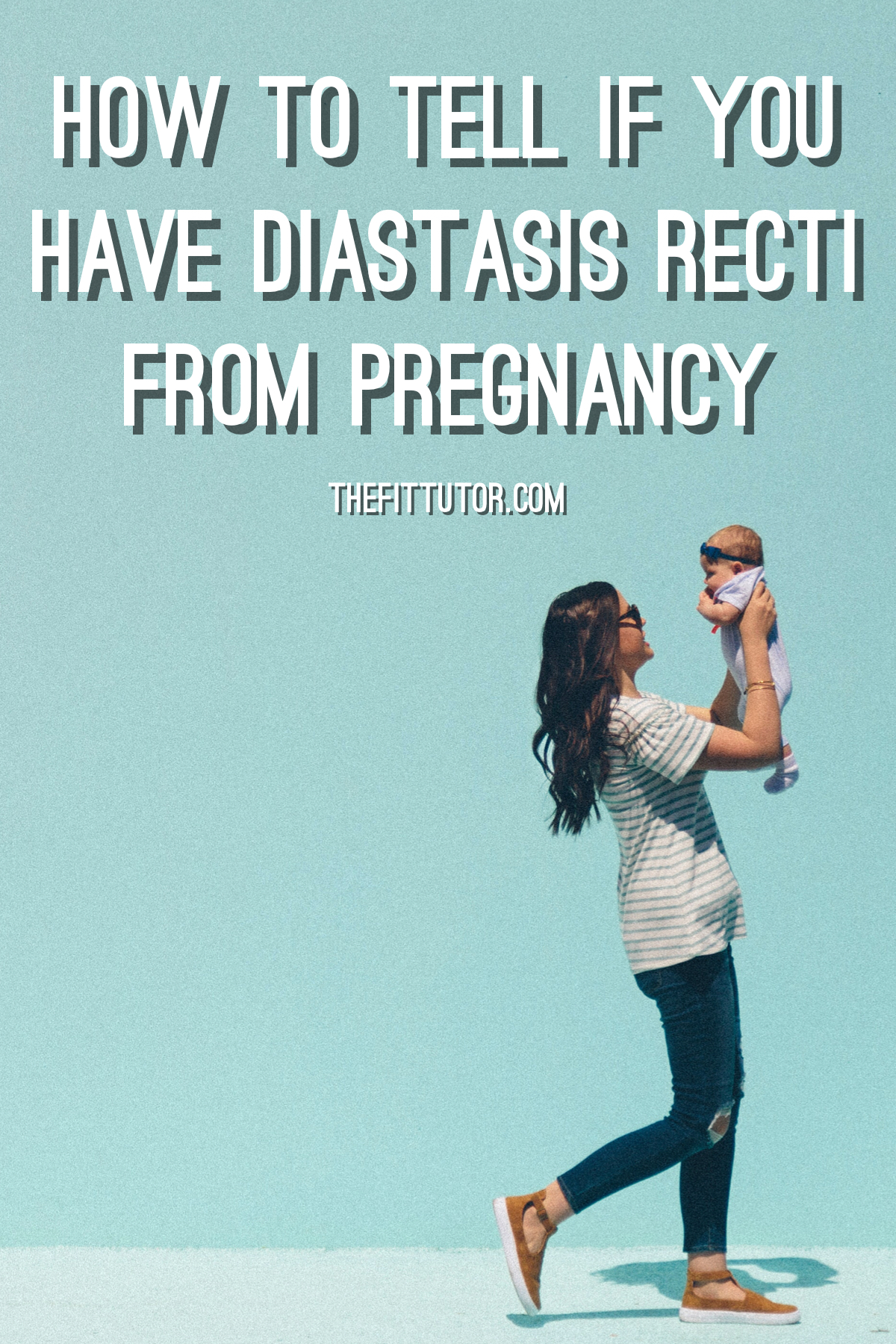What’s Diastasis Recti?
A diastasis recti [pronounced: dī-ăs′tə-sĭs rec-tie] is when your connective tissue between your abs stretches out. This is most common in pregnancy, occurring in about 30% of all pregnancies. This is not commonly tested for, so that statistic is probably too low. It’s not limited to pregnancy, though, and can even happen in men!
Your connective tissue between the right and left sides of your rectus abdominis (abs) is called the Linea Alba. During pregnancy, it’s supposed to stretch out to make room for your growing baby. However, a diastasis becomes harmful when the separation is too large and won’t fully heal on its own. There’s not a gap or hole between your abs, just overstretched connective tissue. Sometimes your habits or activities can contribute to the extra separation or keep it from healing, but more on that later!

Here’s what the Rectus Abdominus (6 pack muscles) look like. The line between them is the linea alba. Source: CC BY-SA 3.0, https://commons.wikimedia.org/w/index.php?curid=238610
Since your connective tissue stretching during pregnancy is normal, a diastasis recti (DR) is considered harmful when the distance between the right and left side is greater than two finger-widths apart. This is a general standard, however, since the width of the linea alba varies.
What are the Consequences of a Diastasis Recti?
Stretched out connective tissues sounds bad enough, right? The consequences much more than just a “mummy tummy”– where you carry the pride of childbearing over your yoga pants the rest of your life — if that wasn’t enough! Some of the effects of DR are
- incontinence
- back, pelvic, hip pain
- inability to fully contract abs/brace core
- this puts you at a greater risk for injury
- intestinal issues
- pelvic organ prolapse
- if you’ve not heard of this, look it up only if you want nightmares
- slow to no progress in training
I believe the consequences of “mummy tummy” are far-reaching. If a woman works out and eats healthier only to never see her stomach shrink in size, it increases her chances of giving up and not taking good care of herself. It can also increase her chance for depression and anxiety, and in some cases, can push women to do extreme dieting which is harmful as well.
If any of these consequences sound like symptoms you experience, I encourage you to perform the DR test below, and ask your OBGYN, doctor, or physiotherapist about this condition. A tummy that sticks out well past pregnancy and peeing a little when you laugh may be common, but they are not normal. They are also not things you have to live with!
I think the best news is a controlled exercise program can work miracles without surgery or intense rehab, depending on your case. More on that below.
Steps to Determine if You Have Diastasis Recti
I would recommend seeing a doctor, personal trainer, or having your partner or a family member help you check for this. Watch this video for instructions. Help and a second opinion can be valuable if you’ve never checked for DR before. Make sure you have something ready to record your results:
Remember, a small separation can be normal and heal in the first few weeks postpartum. If the finger width is two or more, special exercises and precautions need to be taken.
Note: if you feel anything out of the ordinary, like a painful bulge in the abdomen, contact your OBGYN or doctor.
A very small gap might be considered “normal” but you could still exhibit all or many of the negative side effects of DR. This potentially means your abdominal wall is extremely weak, so you would greatly benefit from an exercise program designed to help you close the gap, strengthen your core and pelvic floor, all while helping you reach your other goals, like losing any extra weight and getting stronger!
You can re-check this every 2-3 weeks or so. Be patient, and don’t obsessively check since you would be adding unnecessary pressure to your linea alba.
What to do if You Have a Diastasis Recti
First off, I’m going to encourage you to talk with your doctor/OBGYN/physiotherapist. They can help you assess the severity and help you make a plan for recovery.
Here are some other things you can focus on to help the healing process:
Focus on Your Posture and Alignment
You’ll want to stay in proper alignment as much as possible throughout your day. Think head over heart, heart over hips. It might help to put your hands on your hips or your ribcage to see if either are flaring out or tucked under. You can watch this video to help with alignment:
Think about this as you pick up your kids, wash the dishes, sit at your desk, whatever you are doing. When you aren’t in proper alignment, it can add pressure to your abdominal wall or pelvic floor, adding to the problems you are already experiencing. This can be a tough habit to create, but you can do it!
Focus on Core Breathing
Core breathing, sometimes called diaphragmatic breathing will help strengthen your core musculature (your core is much more than just your abs!) as well as your pelvic floor.
To perform this type of breath
- Place one hand on your lower stomach, the other on the side of your ribcage.
- Take a deep breath, feeling for your belly and lungs to fill up (instead of your neck or shoulders to rise up)
- Exhale slowly and fully, feeling for these areas to deflate
- Once you’ve exhaled (or at the end of your breath) perform a light kegel.
- Repeat! Start with a few sets of 10, add them in while you’re driving, and eventually try to do them more throughout your day.
- A note about doing 10,000 kegels here
Avoid any Type of Exercise that Would Put Pressure on Your Abdominal Wall or Pelvic Floor
This little section will eventually get its own article, but for now, avoid running, jumping, crunching, front planking or anything like it!
Sounds kind of hard, right? I’ll explain what you CAN do below! Don’t worry, it’s enough to still get you stronger and lose any extra pounds you may have!
You’ll also want to eliminate these movements from every day life, like crunching up to sit up in bed or pushing yourself up from lying on the floor. If you have a DR from pregnancy, think back to how you were instructed to get up or down safely once your belly got significantly bigger, or watch this video for instructions:
Follow this Workout Program to Close Your Diastasis, Rebuild Your Pelvic Floor, and Help You Get in Shape
The list of dos and don’ts can feel overwhelming. That’s why I’ve added a Postpartum Strength Training Program to The Fit Tutor workouts. I have countless stories of closed diastases, from new mamas to mamas of grade school kiddos!
The program is 3 months long, but the workouts are short and made for busy schedules. You only need to workout 2-3 times a week. Everything in the program is safe for a woman with DR, which will give you the freedom to follow it without worry.
To get access to the program you’ll need to be a member or you can buy the program individually. The program comes with access to my Nutrition Course, Meal Plans, Weekly Workouts for when your DR is closed, my Get Fit Program, Exercise Library, and Workout Creator for only $49. A full membership includes all that + access to all workout programs and discounts on group fitness challenges for only $100 more. You choose!
Click here to buy the Restore and Postpartum Program now!
Click the button below to check out my Fit for Life plan and Online Personal Training options. You can find more about the Postpartum Strength Program here!
Please share with any friends who can’t seem to get their bellies flat since pregnancy or pee every time they sneeze. These things are so common, but they don’t need to be! A small diastasis can close on its own right after pregnancy, but if yours is lingering or is larger, you need to be proactive in closing it. This program will help you heal and allow a flat stomach to be in your future!



Comments are closed.